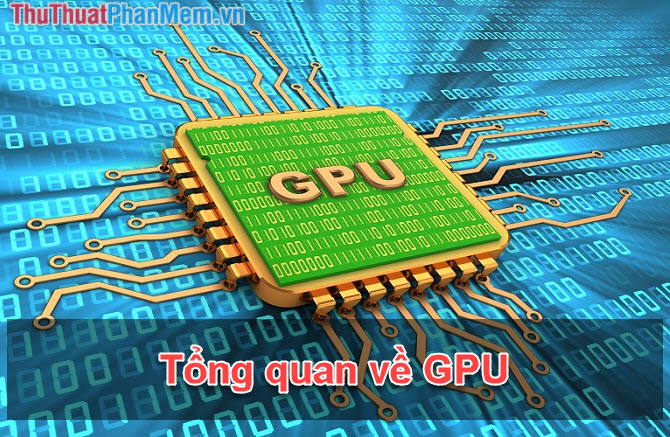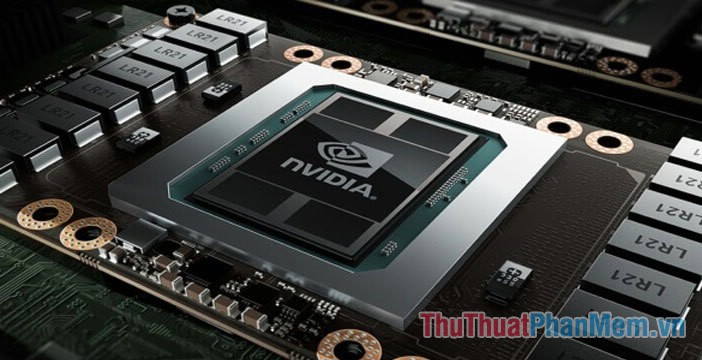What is a GPU?
What is a GPU? What are the uses and functions of the GPU? Why is it an important component that directly affects the workability of computers? Surely not everyone knows and understand this. So let TipsMake.com find out and answer these questions.

What is a GPU?
GPU is an acronym for Graphics Processing Unit - called a dedicated graphics processing unit to receive the task of accelerating and processing graphics for the central CPU. GPUs have outstanding features that go far beyond basic graphics drivers (such as Intel's GPUs).
Overview of GPU
Modern GPUs have very high productivity in computer graphics processing. With its powerful parallel processing structure, the GPU data processing speed can receive thousands of data streams at the same time so it is possible to accelerate some software more than 100 times compared to a CPU.
The GPU is used in embedded systems, mobile phones, personal computers, workstations, game consoles, etc. In personal computers, a GPU can appear on the graphics card, or Can also be mounted on mainboard.
The GPU is also an electronic chip but functions as a separate processor of the graphics card, which itself has the ability and power to handle all problems related to the image of the computer. The two most popular series of graphics chips are: NVIDIA and AMD

Before the advent of the GPU, the CPU had to handle computer programs, data and graphics and image processing at the same time. The amount of work is too much, so the CPU operates in an evenly distributed manner. Graphic work and office work both receive the same amount of resources. Therefore, the graphic products were born very limited.
The GPU was first introduced and introduced on August 31, 1999 by NVIDIA and is considered the most popular parallel processor to date. Based on unfulfilled expectations for real-time, real-time graphics capabilities, the GPU has evolved into a processor that can perform floating-point calculations as well as the ability to create submit. Today's GPUs truly surpass CPUs in their arithmetic and memory bandwidth capabilities, making them the ideal processor to speed up many different parallel data processing applications.
Since GPU Computing (GPU Computing), everything has changed completely to reduce the workload for the CPU, the CPU has only the task of dragging the system to run the GPU's operation and devoting its pulse to other tasks of the system, saving considerable time, solving pressures in providing a high quality product to the market, .
Some GPU applications can be mentioned such as: Graphics, 3D Design, Image Processing, effects in movies and animation, some GPU series for gaming .

Through the above article, TipsMake.com is convinced that you have understood some of the overview and concept of GPU and its role. Thank you for watching!
May be interested
- Check out the 'buffalo' Pokémon in Pokémon Go
 each type of pokemon has hp, cp, ability to attack and endure differently. based on these indicators, players can determine as well as choosing the most powerful pokemon for their offensive tactics.
each type of pokemon has hp, cp, ability to attack and endure differently. based on these indicators, players can determine as well as choosing the most powerful pokemon for their offensive tactics. - Sitting home can also locate Pokemon around, do you believe it?
 the tightening of the niantic developers' rules to prevent players from abusing the support tools also brings annoyance, such as those who have no conditions to move much, go away, it is hard to know. get the location of the pokemon around the area they live in
the tightening of the niantic developers' rules to prevent players from abusing the support tools also brings annoyance, such as those who have no conditions to move much, go away, it is hard to know. get the location of the pokemon around the area they live in - 5 undeniable benefits when playing Pokemon Go
 get to know many new people, breathe fresh air, relieve stress, increase concentration thanks to going out for a walk .... are compelling reasons to force you to try pokemon go now .
get to know many new people, breathe fresh air, relieve stress, increase concentration thanks to going out for a walk .... are compelling reasons to force you to try pokemon go now . - Want to earn the fastest Pokécoins in Pokémon Go? So don't miss this article!
 pokécoins in pokémon go play the role of buying items in the store. the more coins you earn, the more likely you are to buy more items. to earn pokécoins, players will have to complete certain tasks or buy real money.
pokécoins in pokémon go play the role of buying items in the store. the more coins you earn, the more likely you are to buy more items. to earn pokécoins, players will have to complete certain tasks or buy real money. - Pokémon systems when fighting in Pokémon Go
 each pokémon system in pokémon go has different strengths, along with a specific weakness. this type of pokémon will have the power to attack the other pokémon, but can defeat the other pokémon. if you know the characteristics of each type, it will be easier to choose which pokémon to battle.
each pokémon system in pokémon go has different strengths, along with a specific weakness. this type of pokémon will have the power to attack the other pokémon, but can defeat the other pokémon. if you know the characteristics of each type, it will be easier to choose which pokémon to battle. - The terms you need to know when playing Pokémon Go
 pokémon go is the most prominent name in recent days. this game of capturing and training virtual animals has created a relatively new way of playing, as players have to constantly move to catch pokémon. during the process of joining pokémon go, you will encounter and use a lot of important terms. so what do they mean?
pokémon go is the most prominent name in recent days. this game of capturing and training virtual animals has created a relatively new way of playing, as players have to constantly move to catch pokémon. during the process of joining pokémon go, you will encounter and use a lot of important terms. so what do they mean? - How to play Pokemon GO on Windows computers
 recently, pokemon go has become a popular game, attracting thousands of gamers around the world. in previous posts network administrator has guided you on how to play pokemon go on android devices and ios devices. in the article below, network administrator will guide you how to play pokemon go on windows computers using bluestacks emulator software.
recently, pokemon go has become a popular game, attracting thousands of gamers around the world. in previous posts network administrator has guided you on how to play pokemon go on android devices and ios devices. in the article below, network administrator will guide you how to play pokemon go on windows computers using bluestacks emulator software. - How to become a good Pokémon Go hunter?
 with a new way of playing, pokémon go has created a new phenomenon in the game village around the world. players will have to go around and find pokémon for themselves. so how to quickly catch pokémon and in large numbers?
with a new way of playing, pokémon go has created a new phenomenon in the game village around the world. players will have to go around and find pokémon for themselves. so how to quickly catch pokémon and in large numbers? - Things to know to upgrade Pokémon in Pokémon Go
 the whirlwind pokémon go has spread its power right on the first day of its release. everyone rushed to the street to find a pokémon for themselves. therefore, in order to become a pokémon hunter, you need to master the basics of participating in pokémon go battlefield.
the whirlwind pokémon go has spread its power right on the first day of its release. everyone rushed to the street to find a pokémon for themselves. therefore, in order to become a pokémon hunter, you need to master the basics of participating in pokémon go battlefield. - List of medals received in Pokemon Go
 in addition to getting items when leveling up, gamers who join pokemon go also have the opportunity to receive their proud achievements.
in addition to getting items when leveling up, gamers who join pokemon go also have the opportunity to receive their proud achievements.










 What is VGA? Some common types of VGA today
What is VGA? Some common types of VGA today How to check the bottle thickness of laptop dell, hp, asus, ... does not need software
How to check the bottle thickness of laptop dell, hp, asus, ... does not need software How much cpu temperature is normal
How much cpu temperature is normal Distinguish & compare Core i3, i5, i7, i9 CPUs
Distinguish & compare Core i3, i5, i7, i9 CPUs Distinguish & compare Intel CPUs
Distinguish & compare Intel CPUs How to Reset Wifi TP-Link to factory defaults
How to Reset Wifi TP-Link to factory defaults